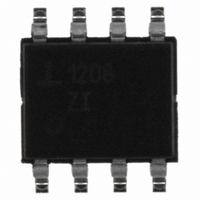ISL1208IB8Z Intersil, ISL1208IB8Z Datasheet - Page 15

ISL1208IB8Z
Manufacturer Part Number
ISL1208IB8Z
Description
IC RTC LP BATT BACKED SRAM 8SOIC
Manufacturer
Intersil
Type
Clock/Calendar/NVSRAMr
Datasheet
1.ISL1208IB8Z-TK.pdf
(24 pages)
Specifications of ISL1208IB8Z
Memory Size
2B
Time Format
HH:MM:SS (12/24 hr)
Date Format
YY-MM-DD-dd
Interface
I²C, 2-Wire Serial
Voltage - Supply
2.7 V ~ 5.5 V
Operating Temperature
-40°C ~ 85°C
Mounting Type
Surface Mount
Package / Case
8-SOIC (3.9mm Width)
Lead Free Status / RoHS Status
Lead free / RoHS Compliant
Available stocks
Company
Part Number
Manufacturer
Quantity
Price
Company:
Part Number:
ISL1208IB8Z
Manufacturer:
Intersil
Quantity:
5 300
Part Number:
ISL1208IB8Z
Manufacturer:
INTERSIL
Quantity:
20 000
Company:
Part Number:
ISL1208IB8Z-TK
Manufacturer:
STC
Quantity:
1 000
Part Number:
ISL1208IB8Z-TK
Manufacturer:
INTERSIL
Quantity:
20 000
Below are examples of both Single Event and periodic
Interrupt Mode alarms.
Example 1 – Alarm set with single interrupt (IM=”0”)
A single alarm will occur on January 1 at 11:30am.
A. Set Alarm registers as follows:
B. Also the ALME bit must be set as follows:
xx indicate other control bits
After these registers are set, an alarm will be generated when
the RTC advances to exactly 11:30am on January 1 (after
seconds changes from 59 to 00) by setting the ALM bit in the
status register to “1” and also bringing the IRQ output low.
Example 2 – Pulsed interrupt once per minute (IM=”1”)
Interrupts at one minute intervals when the seconds register
is at 30 seconds.
A. Set Alarm registers as follows:
B. Set the Interrupt register as follows:
xx indicate other control bits
REGISTER
REGISTER
REGISTER
REGISTER
CONTROL
CONTROL
ALARM
ALARM
MNA
MOA
DWA
HRA
DWA
SCA
DTA
MNA
MOA
SCA
HRA
DTA
INT
INT
7 6 5 4 3 2 1 0 HEX
0 0 0 0 0 0 0 0
1 0 1 1 0 0 0 0
1 0 0 1 0 0 0 1
1 0 0 0 0 0 0 1
1 0 0 0 0 0 0 1
0 0 0 0 0 0 0 0
7 6 5 4 3 2 1 0 HEX
1 1 x x 0 0 0 0 x0h Enable Alarm and Int
7 6 5 4 3 2 1 0 HEX
1 0 1 1 0 0 0 0 B0h Seconds set to 30,
0 0 0 0 0 0 0 0 00h Minutes disabled
0 0 0 0 0 0 0 0 00h Hours disabled
0 0 0 0 0 0 0 0 00h Date disabled
0 0 0 0 0 0 0 0 00h Month disabled
0 0 0 0 0 0 0 0 00h Day of week disabled
7 6 5 4 3 2 1 0 HEX
0 1 x
x 0 0 0 0
BIT
BIT
BIT
BIT
15
B0h Minutes set to 30,
00h Seconds disabled
91h Hours set to 11,
81h Date set to 1,
81h Month set to 1,
00h Day of week
x0h Enable Alarm
Mode
enabled
DESCRIPTION
DESCRIPTION
enabled
enabled
enabled
enabled
disabled
DESCRIPTION
DESCRIPTION
ISL1208
Once the registers are set, the following waveform will be
seen at IRQ-:
Note that the status register ALM bit will be set each time the
alarm is triggered, but does not need to be read or cleared.
User Registers
Addresses [12h to 13h]
These registers are 2 bytes of battery-backed user memory
storage.
I
The ISL1208 supports a bidirectional bus oriented protocol.
The protocol defines any device that sends data onto the
bus as a transmitter and the receiving device as the receiver.
The device controlling the transfer is the master and the
device being controlled is the slave. The master always
initiates data transfers and provides the clock for both
transmit and receive operations. Therefore, the ISL1208
operates as a slave device in all applications.
All communication over the I
sending the MSB of each byte of data first.
Protocol Conventions
Data states on the SDA line can change only during SCL
LOW periods. SDA state changes during SCL HIGH are
reserved for indicating START and STOP conditions (See
Figure 12). On power-up of the ISL1208, the SDA pin is in
the input mode.
All I
condition, which is a HIGH to LOW transition of SDA while
SCL is HIGH. The ISL1208 continuously monitors the SDA
and SCL lines for the START condition and does not
respond to any command until this condition is met (See
Figure 12). A START condition is ignored during the
power-up sequence.
All I
condition, which is a LOW to HIGH transition of SDA while
SCL is HIGH (See Figure 12). A STOP condition at the end
of a read operation or at the end of a write operation to
memory only places the device in its standby mode.
An acknowledge (ACK) is a software convention used to
indicate a successful data transfer. The transmitting device,
either master or slave, releases the SDA bus after
transmitting eight bits. During the ninth clock cycle, the
2
C Serial Interface
2
2
C interface operations must begin with a START
C interface operations must be terminated by a STOP
RTC AND ALARM REGISTERS ARE BOTH “30”s
60s
2
C interface is conducted by
September 12, 2008
FN8085.8












